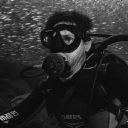In the visualization of the climate crisis, how can ocean acidification be represented?
Ocean acidification is a change to the ocean’s chemistry produced by rising levels of carbon dioxide (CO2). The ocean absorbs about 30 percent of the CO2 that human activity releases into the atmosphere, and as levels of atmospheric CO2 increase, so do the levels in the ocean.
When CO2 is absorbed by seawater, a series of chemical reactions occur that damage structures such as sea shells and coral skeletons. This harms calcifying organisms such as oysters, clams, sea urchins, shallow-water corals, deep-sea corals, and calcareous plankton. When these organisms are at risk, the entire food web may also be at risk.
How can this phenomenon be visualized? How can visual storytellers work with scientists and develop a narrative that shows the problem and points the way toward solutions? What messages can have a tangible impact on a local and global level? How can we communicate the connection between issues in the Atlantic Ocean, the corals in the Philippines? and life and habits in Europe?
To address these issues, Katherine Jack (photographer) and Octavio Aburto (research scientist) is in conversation with Maria Teresa Salvati (founder and director of Everything is Connected). The talk is moderated by Paul Lowe (Reader in Documentary Photography at UAL, London).




